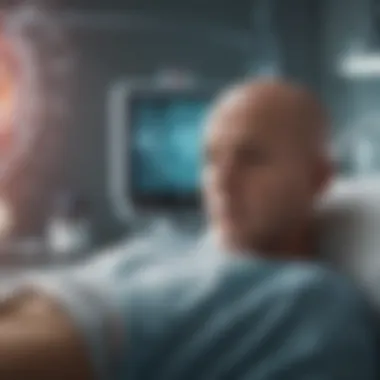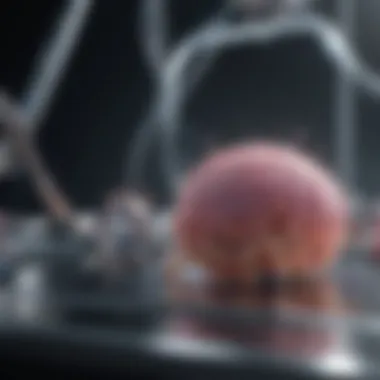Understanding ATC and Chemotherapy: Insights Unveiled


Intro
In the realm of pharmacology and oncology, the need for an organized system to categorize medications is paramount. The Anatomical Therapeutic Chemical (ATC) classification system plays a critical role in this landscape, particularly as it relates to chemotherapy. Chemotherapy remains a fundamental component in the arsenal against cancer, and understanding the connection between ATC classification and these potent agents is vital for researchers and practitioners alike.
Overview of Research Topic
Brief Background and Context
Developed by the World Health Organization in the late 1970s, the ATC classification system assigns medications to specific groups based on their anatomical and therapeutic properties. This is especially significant in oncology, where the fine distinction between various chemotherapeutic agents can influence treatment regimens and patient outcomes. Chemotherapy adheres to this system, enabling healthcare professionals to select appropriate interventions based on precise classifications.
Importance in Current Scientific Landscape
The intersection of ATC classification and chemotherapy is increasingly important as new medications are developed and existing treatments are refined. Understanding this relationship not only aids in enhanced patient care but also facilitates research into how different drugs can be utilized more effectively. Furthermore, with the complexity of cancer treatment expanding, a robust classification system is needed to adapt and respond to emerging challenges.
"In the evolving field of cancer treatment, the integration of effective classification systems like ATC is essential for optimal therapeutic outcomes."
Methodology
Research Design and Approach
This analysis employs a comprehensive design, synthesizing existing literature and utilizing case studies to illustrate the role of ATC at the intersection of chemotherapy. Several methodologies are used to evaluate both historical and contemporary views on drug classifications, highlighting trends over time.
Data Collection Techniques
Various data collection techniques will be employed, including:
- Literature reviews: Analyzing peer-reviewed articles and clinical trials pertaining to ATC classification and chemotherapy.
- Case studies: Evaluating specific instances of drug application in cancer treatment, focusing on their classification.
- Surveys: Gathering insights from healthcare professionals about their usage and understanding of ATC classifications in practice.
By combining these approaches, the discourse surrounding ATC and chemotherapy can be illuminated, providing valuable insights for students, researchers, educators, and professionals engaged in this vital field.
Prelude to Chemotherapy
Chemotherapy plays a critical role in the treatment of cancer. It involves the use of drugs that target and kill rapidly dividing cells, one of the hallmarks of cancer. Understanding chemotherapy is essential for grasping how it interacts with various treatment modalities and classifications, particularly the Anatomical Therapeutic Chemical (ATC) classification system. This section serves to provide a solid foundation before exploring more complex relationships between ATC and chemotherapeutic agents.
The importance of this topic lies in its implications for treatment options and decision-making in oncology. By comprehending the definition, purpose, and history of chemotherapy, healthcare professionals can better tailor therapeutic approaches.
Definition and Purpose
Chemotherapy refers to the use of chemical agents or drugs to treat disease, most commonly cancer. The main purpose of chemotherapy is to inhibit the growth of cancer cells, effectively shrinking tumors or eliminating malignant cells. Various chemotherapeutic agents can be administered in different schedules and forms, including oral pills, intravenous infusions, or injections. It is critical as it provides patients with a chance to overcome cancer and improve survival rates.
Despite its effectiveness, chemotherapy has limitations. The drugs can affect healthy cells, leading to side effects. Thus, the challenges posed by chemotherapy make it a complex but vital component of cancer treatment.
Historical Overview
The history of chemotherapy is intertwined with significant advances in medical science. The concept dates back to the early 20th century, when researchers began to explore the effects of various substances on cancer cells. One of the first notable successes came with the discovery of nitrogen mustard, a chemical warfare agent, which proved effective against lymphoma.
Over the decades, chemotherapy evolved. The introduction of various drug classes, such as antimetabolites, alkylating agents, and plant alkaloids, revolutionized treatment. By the 1970s, combination chemotherapy emerged, improving overall efficacy by targeting cancer more aggressively. This historical context is crucial to appreciate the advancements and ongoing research in the field.
"Chemotherapy represents one of the most important advancements in the fight against cancer, transforming patient outcomes over time."
Anatomical Therapeutic Chemical Classification System


The Anatomical Therapeutic Chemical (ATC) classification system is essential in the systematic categorization of medications. It organizes drugs by their anatomical and therapeutic properties, allowing for effective communication and data analysis in healthcare. With the increasing complexity of drug therapies, understanding the ATC system is paramount for healthcare professionals, researchers, and educators.
Overview of the ATC System
The ATC system is a hierarchical structure developed by the World Health Organization. It classifies drugs into different levels based on their anatomical sites and pharmacological classes. Each medication receives a unique code that reflects its chemical characteristics, therapeutic use, and the anatomical location where it acts.
- Anatomical Level: This first level classifies drugs by the organ or system they affect, such as the cardiovascular system or the nervous system.
- Therapeutic Level: The second level focuses on the therapeutic indications of the drugs, grouping them into categories like antineoplastics or anti-infectives.
- Chemical Subgroups: Subsequent levels provide a more specific breakdown, detailing the chemical structure and mechanism of action.
Such classification is beneficial for obtaining comprehensive data for drug utilization studies, epidemiological research, and pharmacovigilance.
Structure and Categories of ATC
The structure of the ATC system is relatively straightforward yet profound in its applicability. Each ATC code consists of a maximum of seven alphanumeric characters. The first character indicates the anatomical group, while subsequent characters delineate the therapeutic and chemical subgroups.
"The ATC classification aids in ensuring the precise use of chemotherapy agents, which is vital for treatment outcomes."
Categories within the ATC system can be broadly described as follows:
- Anatomical Groups: Including system-based divisions such as:
- Therapeutic Subclasses: Encompassing various treatment areas such as:
- A: Alimentary tract and metabolism
- B: Blood and blood-forming organs
- C: Cardiovascular system
- L: Antineoplastic and immunomodulating agents
- J: Antiinfectives for systemic use
The coding structure allows for quick identification of drug classes, fostering a better understanding of their interactions and potential side effects. This comprehensive classification system is not only crucial for drug prescribers but also serves as a foundation for health policy and regulatory measures in the context of chemotherapy and beyond.
Relationship Between ATC and Chemotherapeutic Agents
The relationship between Anatomical Therapeutic Chemical (ATC) classification and chemotherapeutic agents plays a crucial role in oncology. It enhances the organization of drugs within the broader context of cancer treatment. ATC provides a framework to categorize medications based on their anatomical and therapeutic properties. This categorization is essential for healthcare professionals to understand drug actions, dosages, and potential interactions. By utilizing ATC, practitioners can more effectively match the right medication to a patient’s specific needs. This precision leads to optimized treatment outcomes.
Categorization of Chemotherapy Drugs
In chemotherapy, drugs are categorized into different classes based on their mechanisms of action, structures, and clinical applications. Some significant categories based on the ATC classification include:
- Alkylating Agents: These drugs, like cyclophosphamide, damage the DNA of cancer cells, preventing them from dividing.
- Antimetabolites: Medications such as methotrexate interfere with DNA synthesis and replication.
- Anthracyclines: This class includes doxorubicin, known for its potency against various cancers through its impact on the topoisomerase enzyme.
- Taxanes: Drugs like paclitaxel disrupt normal cell division, which is vital in treating tumors.
Each category addresses different molecular pathways relevant to cancer, allowing for more tailored therapeutic approaches. This systematic approach aids clinicians in identifying suitable therapies and contributes to evidence-based treatment protocols.
Clinical Relevance of ATC in Treatment Plans
The clinical relevance of ATC in treatment plans cannot be overstated. Firstly, it provides a unified language for healthcare professionals, which is critical when discussing treatment modalities. It ensures that oncologists and pharmacists are on the same page regarding which drugs are employed and their expected outcomes.
Moreover, the ATC classification helps identify drug interactions and side effects that may arise from specific regimens. This knowledge allows for better patient monitoring and follow-up strategies, significantly improving patient safety and treatment effectiveness. It also assists in clinical trial design, aiding researchers in evaluating new therapies against standardized classifications.
Types of Chemotherapy
Chemotherapy is not a homogenous form of treatment. Its effectiveness can greatly vary based on the specific type employed. Understanding the different types of chemotherapy is crucial in tailoring treatment plans for patients. Each type carries distinct mechanisms, advantages, and considerations. This section provides an in-depth look into the traditional methods, targeted therapies, and immunotherapies that constitute the diverse landscape of chemotherapy.
Traditional Chemotherapy
Traditional chemotherapy encompasses a range of cytotoxic drugs designed to kill rapidly dividing cells, a hallmark of cancerous tissues. These agents often affect both cancer and normal cells, leading to various side effects. Agents like Doxorubicin, Cyclophosphamide, and Cisplatin are among the most common in clinical practice. Their role is pivotal in many oncology treatment protocols, especially for aggressive and widespread cancers.


Despite its effectiveness, traditional chemotherapy can induce significant adverse effects, such as nausea, fatigue, and immunosuppression. Therefore, it is essential for healthcare providers to monitor patients closely and manage side effects proactively. The trade-off between tumor response and quality of life is an ongoing deliberation.
"Traditional chemotherapy represents a robust, albeit challenging, approach to cancer treatment that has evolved over decades."
Targeted Therapies
Targeted therapies revolutionize the chemotherapy paradigm by focusing on specific molecular targets associated with cancer. Unlike traditional chemotherapy, these treatments aim to minimize damage to normal cells. Agents like Trastuzumab and Imatinib exemplify this strategy, offering effective alternatives against particular cancer types, such as breast and leukemia.
The benefits are clear. Targeted therapies often lead to improved response rates with a more favorable side effect profile. However, their use may be limited to patients whose tumors exhibit certain genetic markers. Thus, careful genetic testing is integral prior to initiation of such therapies. This approach necessitates a deep understanding of tumor biology and personalized medicine.
Immunotherapy
Immunotherapy represents another significant advancement in cancer treatment, activating the body's immune system to combat cancer cells. Agents like Nivolumab and Pembrolizumab leverage the immune response, highlighting the intrinsic relationship between immunity and oncology.
Immunotherapy has shown promise for a range of cancer types. It offers a unique mechanism of action that can lead to durable responses in some cases. However, not every patient is a suitable candidate, and predictability of response can vary widely. Common side effects include immune-related adverse events, which require careful management. Thus, a thorough discussion of benefits and risks is necessary.
In summary, the exploration of different types of chemotherapy is vital. Each class provides unique methods for tackling cancer, contributing to the overall understanding and effectiveness of cancer treatment strategies.
Effectiveness of Chemotherapy
The effectiveness of chemotherapy remains a crucial aspect in cancer treatment. It directly impacts the approach of healthcare professionals and the outcomes for patients. Scientific research consistently aims at assessing how effective chemotherapy is for various types of cancers, providing valuable insights into treatment protocols and patient management.
Chemotherapy works by targeting rapidly dividing cells in the body. While its primary focus is on cancerous cells, it may also affect healthy cells, leading to side effects. Understanding the effectiveness means evaluating both the response rates and the factors that influence those rates across different demographics and cancer types.
Response Rates in Different Cancers
Response rates to chemotherapy differ significantly among various cancer types. For instance, cancers such as leukemia and testicular cancer often demonstrate high response rates, with some patients achieving complete remission. On the other hand, certain solid tumors, like pancreatic and ovarian cancers, may exhibit lower response rates.
Here are some important points:
- High-response cancers: Cancers like lymphoma and breast cancer show notable improvement among chemotherapy patients, enhancing survival rates.
- Low-response cancers: Cancers such as glioblastoma tend to be more resistant, with limited effectiveness of standard chemotherapy regimens.
- Combination therapies: Employing chemotherapy in conjunction with radiation or immunotherapy can elevate response rates, especially in aggressive cancer types.
Each cancer type's biology, genetic factors, and overall patient health are critical when assessing treatment effectiveness. This complicates the prediction of outcomes and necessitates a tailored approach.
Factors Influencing Outcomes
Several factors influence the effectiveness of chemotherapy and, consequently, the outcomes for patients. It is important to identify these factors to enhance treatment strategies. Here are some notable influences:
- Tumor characteristics: The type, size, location, and genetic makeup of the tumor significantly affect how well chemotherapy can work. For example, tumors with specific genetic mutations may respond differently to conventional chemotherapy.
- Patient health: A patient’s overall health, including age, comorbidities, and organ function, can impact how well their body tolerates chemotherapy. Patients in better health typically show improved outcomes.
- Previous treatments: Prior exposure to cancer therapies can lead to resistance, making future chemotherapy less effective.
- Adherence to treatment: Compliance with the prescribed treatment schedule directly impacts effectiveness. Missing doses or delaying treatment can diminish response rates.
Evaluating these factors not only helps in determining the course of treatment but also sheds light on the need for personalized medicine in oncology.
"Chemotherapy's effectiveness can vary greatly and must be assessed based on individual patient contexts to optimize treatment plans."
Adverse Effects of Chemotherapy
Understanding the adverse effects of chemotherapy is crucial for appreciating the full scope of cancer treatment. Chemotherapy is a powerful tool that targets rapidly dividing cells, including cancer cells. However, it does not discriminate and can affect healthy cells as well. This section will elucidate the common side effects experienced by patients undergoing chemotherapy and explore the long-term consequences that can arise from treatment. It is essential for both healthcare professionals and patients to be aware of these effects to manage them effectively and maintain quality of life.
Common Side Effects
Chemotherapy is notorious for its side effects, many of which can be debilitating. Among the common side effects associated with chemotherapy are:


- Nausea and Vomiting: Many patients report nausea, which can occur due to the drug's effects on the stomach lining. Anti-nausea medications are often prescribed.
- Fatigue: A prevalent side effect, fatigue can severely impact daily activities and overall well-being.
- Hair Loss: This is often what patients fear most. Hair loss can affect not just the scalp but also eyebrows, eyelashes, and body hair.
- Mouth Sores: Chemotherapy can lead to painful sores, making eating and speaking uncomfortable.
- Changes in Appetite: Patients may experience alterations in taste and smell, leading to fluctuating appetite.
Managing these side effects is vital. Supportive care and patient education play an essential role in addressing and mitigating discomfort during treatment.
Long-term Consequences
While many side effects are temporary and resolve after treatment, some can have long-term consequences. These consequences may present difficulties that impact patients' lives well after the last chemotherapy session. Notable long-term effects include:
- Cognitive Impairment: Often referred to as "chemobrain," some individuals report problems with memory, attention, and cognitive function.
- Organ Damage: Certain chemotherapeutic agents can lead to damage in organs like the heart or lungs, affecting long-term health.
- Increased Risk of Secondary Cancers: Some studies suggest a higher risk of developing other malignancies due to the effects of chemotherapy.
- Infertility: Chemotherapy can affect reproductive health, leading to challenges with fertility in both men and women.
Being informed about these potential long-term consequences enables patients and healthcare providers to make informed decisions and plan appropriate follow-up care.
"Understanding the adverse effects of chemotherapy is crucial for maintaining a patient’s quality of life during and after treatment."
By addressing both common side effects and long-term consequences, this article aims not only to inform but also to promote awareness and proactive management strategies for those undergoing chemotherapy.
Future Directions in Chemotherapy
The field of chemotherapy is undergoing significant transformation. Understanding future directions in this area is crucial for professionals and researchers alike. As the landscape of oncology evolves, several key elements will shape the future of cancer treatment.
Innovation will play a key role in improving patient outcomes and expanding the available treatment options. This article will delve into innovative drug development and integrative approaches to cancer treatment.
Innovative Drug Development
Innovative drug development focuses on creating new therapeutic agents that target cancer more effectively. This approach is essential as traditional chemotherapeutic agents often lack specificity, leading to toxic side effects and limited efficacy.
Recent advances in molecular biology are paving the way for the design and synthesis of drugs that can specifically target cancer cells, minimizing damage to normal tissue. Examples of these drugs include small molecules, monoclonal antibodies, and antibody-drug conjugates. The increased understanding of cancer genomics has enabled the identification of specific genetic mutations, leading to novel targeted therapies. Understanding the genetic profile of a tumor can guide treatment decisions and enhance the precision of therapy.
This shift towards personalized medicine demonstrates the importance of moving away from a one-size-fits-all approach. Additionally, continued research into combination therapies aims to improve effectiveness and overcome drug resistance, a common issue in cancer treatment.
"The future of cancer treatment relies on innovative strategies that prioritize targeted approaches and personalized medicine."
Integrative Approaches to Cancer Treatment
Integrative approaches offer a holistic perspective on cancer treatment, focusing on combining conventional chemotherapy with complementary therapies. These methods can improve a patient’s overall well-being and potentially enhance the effects of traditional treatments.
Complementary therapies can include lifestyle modifications, nutritional support, psychosocial interventions, and alternative therapies such as acupuncture or meditation. There is growing evidence suggesting that these strategies can help alleviate the side effects of chemotherapy, improve quality of life, and enhance treatment adherence.
Moreover, integrative approaches allow for collaboration between various healthcare professionals, creating a multidisciplinary team dedicated to patient care. This collaborative framework ensures that each patient's unique needs are addressed, leading to more comprehensive and effective treatment plans.
The future of chemotherapy lies in embracing both innovative drug development and integrative approaches. By doing so, the medical community can move towards more effective, patient-centered care that takes into account the various facets of cancer treatment.
Ending
The conclusion serves as a vital component of this article, encapsulating the core elements discussed throughout. It provides a clear summation of key findings related to the Anatomical Therapeutic Chemical (ATC) classification system and its relationship with chemotherapy. Recognizing the overarching importance of these issues not only aids in digesting the information presented but also invites further contemplation into future implications.
Summary of Key Points
Several essential points emerge from our analysis:
- Significance of ATC: The ATC classification system efficiently categorizes chemotherapeutic agents, enhancing clarity in treatment protocols.
- Role of Chemotherapy: As a principal strategy in cancer treatment, chemotherapy continues to evolve with advancements in medical science.
- Emerging Trends: Recent innovations and integrative approaches in cancer treatment highlight an optimistic future for therapy.
- Adverse Effects and Considerations: Understanding the side effects remains crucial for developing comprehensive care strategies.
The insights gained underline the necessity for continuous research and adaptation in the fields of pharmacology and oncology.
Implications for Future Research
Looking ahead, the interplay between ATC classification and chemotherapeutic advancements presents numerous avenues for research:
- Refinement of Classification: Future research could focus on refining the ATC system to accommodate newer cancer therapies, particularly immunotherapy and targeted agents.
- Longitudinal Studies: There is a need for extensive longitudinal studies to assess long-term outcomes and adverse effects of various chemotherapy regimens.
- Personalized Medicine: Investigating how ATC classifications can aid in personalized medicine approaches might enhance treatment effectiveness and patient satisfaction.



